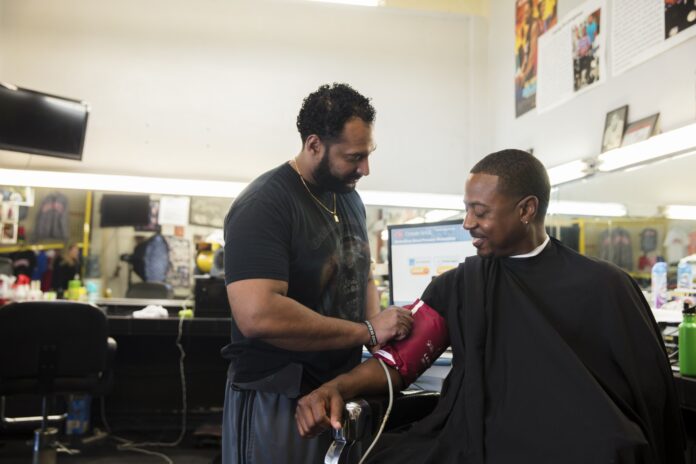As a blood pressure monitor squeezed snugly around his arm, the pharmacist counseled Thomas, 49, on his diet and stress level while checking his blood pressure. She then helped Thomas find a medication better suited for his body. Thomas was not at a health clinic or pharmacy or a primary care physician’s office. He was at the barbershop where he works in Inglewood, California.
As part of a study, these health services were provided at his barbershop and others across Los Angeles County. The study, published Monday in the New England Journal of Medicine, tested whether pharmacist-led programs in barbershops could significantly lower high blood pressure in black men in the United States.
Results from six months after the study, published in March, showed that when the guidance was coupled with medication, a blood pressure level of less than 130/80 was achieved among 63.6% of men who participated in the study’s program, versus 11.7% of those who didn’t.
Many older black men tend to avoid seeing the doctor until they have a serious health problem, and then they “use the emergency room as a doctor,” Thomas said.
“If it wasn’t for the program, a lot of guys wouldn’t have known they had high blood pressure,” he said of the study. “Unfortunately, I wish we had other programs to come in, too.”
The reasons why some black men avoid physicians are complex and sometimes involve a deep-rooted distrust of the medical community. Many men also face geographic, cultural or other barriers to accessing adequate health care.
On the other hand, the barbershop represents a safe haven in the black community — a no-judgment zone — where conversations about health and other personal topics are commonplace.
The prevalence of high blood pressure among black adults in the United States is among the highest in the world, according to the American Heart Association. More than 40% of non-Hispanic black men and women have high blood pressure.
Black Americans also develop high blood pressure more often and at an earlier age than whites and Hispanics, according to the CDC.
By the end of the study, the researchers found that the barbers’ role in encouraging the men to monitor and improve their health resulted in a significant reduction in blood pressure, when coupled with medication from the pharmacists.
As mentioned in this article, hypertension disproportionately affects black men in the U.S. Despite the statistics, there is a widespread mistrust of the medical community amongst black men. Further, many black men experience unequal accessibility to healthcare. All of these factors are barriers to receiving adequate education, prevention, and monitoring methods for hypertension.
The idea of this study was to introduce blood pressure monitoring in an environment that is not typically associated with the medical field to avoid feelings of mistrust. Additionally, participants were more calm when receiving their readings which helps with accuracy.
I included this study because it exemplifies the need for a solution that is accessible for all. Further, within the scope of this project, accessibility goes beyond normal measures and includes trust in the realm of factors to consider.
It also yields evidence and support for a solution that is as dissociated with a typical doctor’s office as possible.




